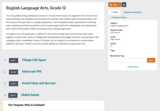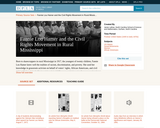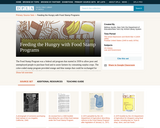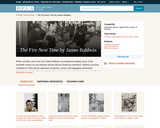
ADRA is a organization associated with the Seventh-day Adventist Church. Its mission is to help improve the quality of life for those in developing countries.
- Subject:
- Social Studies
- Material Type:
- Student Guide
- Date Added:
- 12/01/2023

ADRA is a organization associated with the Seventh-day Adventist Church. Its mission is to help improve the quality of life for those in developing countries.

Non-profit humanitarian organization dedicated to saving lives by "eliminating hunger through prevention, detection, and treatment of malnutrition, especially during and after emergency situations of conflict, war and natural disaster".

Why does both hunger and obesity exist in the United States? That's because food insecurity in America looks very different than in other countries. Spanish captions and transcript also available. [2:54]

Rediscover the complex life and legacy of the author, advocate and human rights pioneer. Helen Keller (1880-1968), who was deaf and blind since childhood, used her celebrity and wit to advocate for social justice, particularly for women, workers, people with disabilities, and people living in poverty. All the videos and support materials in this collection incorporate accessibility features including ASL interpretation, descriptive transcripts, extended audio description, closed captioning, alternative text descriptions for primary source images, and accessible text-based handouts. Visit this resource to learn more about the tools utilized to help make the film Becoming Helen Keller accessible for people who are blind or have limited vision, are deaf or partially deaf, or a combination of both. This Collection includes: Media Gallery (2), Video (12) for Grades 9-12.

Home page for CARE, the global help agency. Page lists current crisis areas around the world.

CAFOD helps the impoverished by promoting long-term development, emergency response, and educating the public about poverty. CAFOD also speaks out on behalf of the poor and promots social justice.

Comida pa los Pobres follows Giovanni, a young Puerto Rican activist, as he confronts the island's persistent crisis of food insecurity. Motivated by his childhood struggle with hunger, he seeks to inspire his fellow citizens to join a movement of solidarity-oriented work by feeding families and college students through mutual aid efforts, all while facing challenges from local authorities. [14:04]

Direct Relief International provides medical assistance and works to improve the health efforts of needy countries. The hope is that the quality of life for the impoverished and displaced will be improved.

The 12th grade learning experience consists of 7 mostly month-long units aligned to the Common Core State Standards, with available course material for teachers and students easily accessible online. Over the course of the year there is a steady progression in text complexity levels, sophistication of writing tasks, speaking and listening activities, and increased opportunities for independent and collaborative work. Rubrics and student models accompany many writing assignments.Throughout the 12th grade year, in addition to the Common Read texts that the whole class reads together, students each select an Independent Reading book and engage with peers in group Book Talks. Language study is embedded in every 12th grade unit as students use annotation to closely review aspects of each text. Teacher resources provide additional materials to support each unit.

Students will consider the different ways that humor can be used by a writer to criticize people, practices, and institutions that he or she thinks are in need of serious reform. Students will read satirists ranging from classical Rome to modern day to examine how wit can be used to make important points about culture.
ACCOMPLISHMENTS
Students research an aspect of modern life that they would like to lampoon.
Students read from satirists across history to absorb the style and forms of humor and institutions satirized.
Students write their own satire, drawing on techniques of famous satirists to criticize their targets.
GUIDING QUESTIONS
These questions are a guide to stimulate thinking, discussion, and writing on the themes and ideas in the unit. For complete and thoughtful answers and for meaningful discussions, students must use evidence based on careful reading of the texts.
What is satire, and when is it too harsh?
How can humor and irony make you more persuasive?
What do you think is funny? How far would you go to satirize it?
Who gets more reaction—satirists or protestors?

In this lesson, students will watch part of a film or television show that uses high school stereotypes, and they’ll analyze various cinematic elements that fuel its satirical power.

This history of the Great Depression looks at its effect on American citizens, including the changes to women's societal roles. Includes photographs.

This collection uses primary sources to explore Fannie Lou Hamer and the civil rights movement in rural Mississippi. Digital Public Library of America Primary Source Sets are designed to help students develop their critical thinking skills and draw diverse material from libraries, archives, and museums across the United States. Each set includes an overview, ten to fifteen primary sources, links to related resources, and a teaching guide. These sets were created and reviewed by the teachers on the DPLA's Education Advisory Committee.

This collection uses primary sources to the history of food stamp programs. Digital Public Library of America Primary Source Sets are designed to help students develop their critical thinking skills and draw diverse material from libraries, archives, and museums across the United States. Each set includes an overview, ten to fifteen primary sources, links to related resources, and a teaching guide. These sets were created and reviewed by the teachers on the DPLA's Education Advisory Committee.

Very extensive report on the poverty trends among females in the U.S. and the reasons for these trends. Also contains information on recent and past poverty rates and ratios.

This collection uses primary sources to explore The Fire Next Time by James Baldwin. Digital Public Library of America Primary Source Sets are designed to help students develop their critical thinking skills and draw diverse material from libraries, archives, and museums across the United States. Each set includes an overview, ten to fifteen primary sources, links to related resources, and a teaching guide. These sets were created and reviewed by the teachers on the DPLA's Education Advisory Committee.

World's largest alliance for improving global health. Non-profit organization.

Hunger is the world’s greatest health risk, claiming more lives than AIDS, malaria, and tuberculosis combined. What can Ohio’s soybean farmers do to address this global issue? This course, brought to you by a partnership between the Ohio Soybean Council and the Columbus Council on World Affairs, will help you find out! Learning objectives: Describe the problem of world hunger and malnutrition, Describe the relationship between poverty, growing population and world hunger, Identify hunger health risks, Compare protein consumption and demand across the world, Understand the role of soy protein

Environmental scientist Ashok Gadgil is perhaps best known for his inventions which include an ultraviolet water purifier that can provide clean, cheap water for a thousand people per day and an inexpensive, ultra-efficient cooking stove for families in Darfur.

The International Medical Corps is a humaritarian, non-profit organization dedicated to saving lives and relieving world suffering by providing health care training and relief.